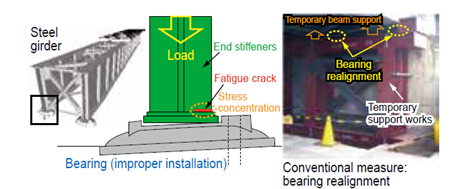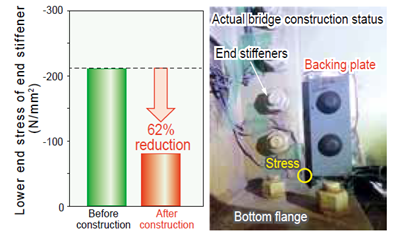10. Reinforcement Method for Preventing Fatigue Cracks at Steel Girder Support Sections
At the support sections of welded steel girders, improper installation of bearings can cause inadequate support of the girder, leading to stress concentration in the welds at the lower end of the edge stiffeners during train passage, which may result in fatigue cracks (Figure 1). To prevent fatigue cracks, it is necessary to improve the bearing installation condition. However, this requires temporarily supporting the girder, which entails considerable costs for installing temporary supports and related work.
Therefore, we developed a reinforcement method that reduces stress concentration at the welds and prevents fatigue cracks by reinforcing the lower end of the edge stiffener with the backing plate (Figure 2). Simply connecting the backing plate to the edge stiffener does not ensure a firm fixing with the bottom flange on the bearing, so it does not share the load during train passage and therefore does not provide effective reinforcement. In this method, the backing plate is pressed and fixed firmly against the bottom flange on the bearing, allowing it to share the load and provide reinforcement. The pressing of the backing plate is performed manually in a short time by shifting the plate toward the bottom flange by driving in bearing bolts, making it applicable even in the confined construction environments around the bearing sections. Since this method allows construction without temporarily supporting the girder, it can prevent fatigue cracks at less than 10% of the cost of conventional methods. The method was applied to an actual bridge, and it was confirmed that the stress at the lower end of the edge stiffener during train passage decreased by approximately 60% after construction (Figure 3).
This method can be utilized as a low-cost preventive maintenance measure for welded steel girders. Specifically, it can be applied in cases such as improper bearing installation, presence of small gaps difficult to adjust, predicted fatigue crack occurrence due to aging, or situations where temporary support of the girder is difficult.
Other Contents
- 9. Design Method for Post-installed Anchor Joint Members in the Reconstruction of Concrete Structures
- 10. Reinforcement Method for Preventing Fatigue Cracks at Steel Girder Support Sections
- 11. Method for Identifying Potentially Critical Locations of Loose Bearing Based on On-board-measured Track Geometry
- 12. Extension of Rail Replacement Cycles Considering Fatigue/Soundness
- 13. Support Method for Extending Inspection Periods Based on Statistical Analysis of Equipment Inspection Records
- 14. Automated Visual Inspection System for Vehicle Underbody
- 15. Autonomous Train Operation System
- 16. General Purpose Real-time Algorithm for Generating Driving Curves for Driver Advisory System
- 17. Method for Updating On-board Databases Using Public Communication Networks
- 18. Labor-saving for Generating Crew Schedule to Enable Workforce Efficiency and Reduce Labor Burden
- 9. Design Method for Post-installed Anchor Joint Members in the Reconstruction of Concrete Structures
- 10. Reinforcement Method for Preventing Fatigue Cracks at Steel Girder Support Sections
- 11. Method for Identifying Potentially Critical Locations of Loose Bearing Based on On-board-measured Track Geometry
- 12. Extension of Rail Replacement Cycles Considering Fatigue/Soundness
- 13. Support Method for Extending Inspection Periods Based on Statistical Analysis of Equipment Inspection Records
- 14. Automated Visual Inspection System for Vehicle Underbody
- 15. Autonomous Train Operation System
- 16. General Purpose Real-time Algorithm for Generating Driving Curves for Driver Advisory System
- 17. Method for Updating On-board Databases Using Public Communication Networks
- 18. Labor-saving for Generating Crew Schedule to Enable Workforce Efficiency and Reduce Labor Burden



